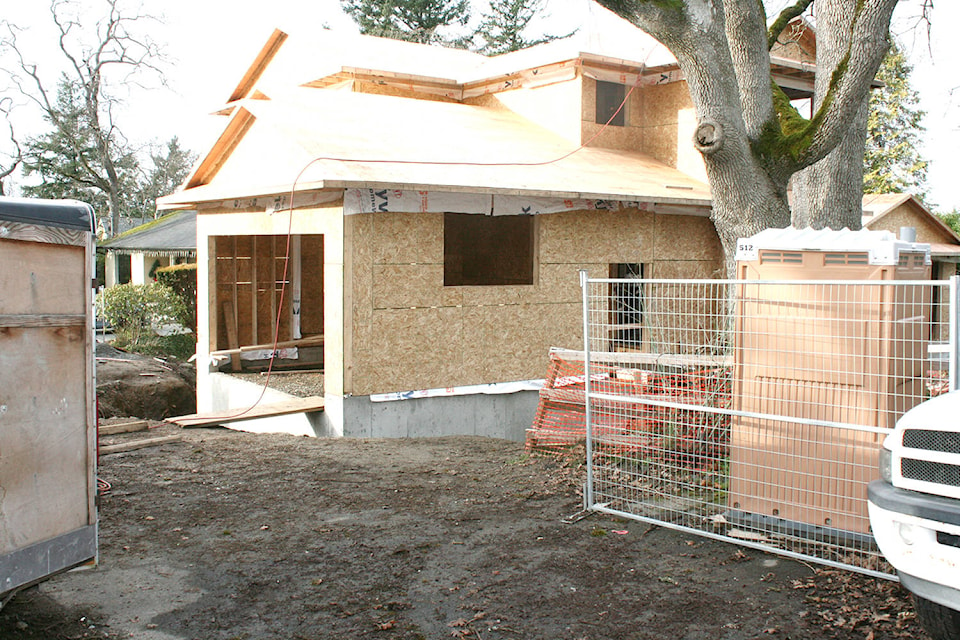Housing starts are up across Vancouver Island, but a closer look reveals significant variations among municipalities, according to new figures from the Canadian Mortgage and Housing Corporation (CHMC).
Housing starts in Greater Victoria continue to trend up, rising 21.2 per cent year-to-date in 2019, despite a drop of more than 45 per cent in Saanich, Vancouver Island’s largest municipality.
Housing starts are also up in Nanaimo, where starts rose almost 64 per cent year-to-date. Courtenay, meanwhile, saw new housing starts rise 82.4 per cent, while Parksville recorded an increase of 138.2 per cent. Campbell River, meanwhile, recorded a drop of 43.1 per cent, while Duncan, recorded a drop of 50 per cent.
Port Alberni recorded an increase of 20 per cent, but from a very low base, with actual housing starts rising by two.
These large fluctuations point to one of the emerging characteristics of the housing market on Vancouver Island, said Braden Batch, a CHMC senior analyst.
Developers are shifting away from single-family homes towards condominium or rental apartments, he said. Accordingly, housing starts can experience sudden spikes, he said.
“You are seeing a demand for more affordable housing and this supply responds to it,” he said.
Of interest is the variation within Greater Victoria, where housing starts have varied widely. Housing starts in the City of Victoria saw a huge increase year-to-date, jumping to 347 starts from 13, with most of the increase in the category of apartments (331). Nearby Esquimalt also recorded a steep increase with new housing starts jumping from four to 78.
RELATED: Pace of Canadian housing starts up in March on seasonally adjusted basis: CMHC
Compare this to Saanich, where housing starts dropped by 45.2 per cent, with the largest drop in the category of apartments. Overall, Vancouver’s Island’s largest community recorded 120 housing starts, down 219 from the previous period of comparison.
Oak Bay, another core community of Greater Victoria, also recorded a drop of almost 47 per cent in new starts year-to-date.
Looking to the outer communities, Langford recorded an increase of 43.4 per cent, with the biggest increase in apartments. Of the 482 new housing starts, 395 were apartments.
Batch said he could not offer a clean reason for the big differences between Saanich and Langford. The availability of building space and general planning processes are among the factors that might account for the differences, he said.
Sooke, meanwhile, recorded a drop of 31.1 per cent, while Colwood recorded a drop of 64 per cent.
The West Shore communities of Metchosin, View Royal and Highlands also recorded significant drops in terms of percentages, but the low number of actual new starts in those communities render those figures nearly meaningless. For example, Highlands has yet to record a housing start, after recording all of two during the previous period.
Figures from the Saanich Peninsula show that Sidney (down 35.7 per cent) and North Saanich (down 82.9 per cent) recorded drops in housing starts, while Central Saanich recorded an increase (80 per cent). Again, actual housing starts in those communities are generally small, leading to significant fluctuations, at least in terms of percentages.
This said, the figure painted is relatively clear. Communities with a rising number of housing starts are building apartments, eschewing single family homes. Of the 1,196 housing starts in Greater Victoria, 887 fell into the category of apartments.
Looking at new housing starts by market type, condominiums accounted for 55 per cent, followed by rentals with 28 per cent.
Just as Victoria experienced a spillover effect from Vancouver’s real estate market, Nanaimo and other communities outside the Capital Region are experiencing a spillover effect from Greater Victoria, said Batch, with the proviso that Nanaimo is also experiencing a spillover effect by virtue of having a direct ferry connection to the Lower Mainland.
hr width=“75%”>
